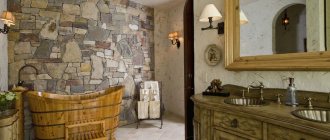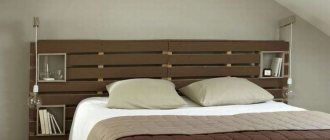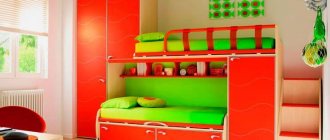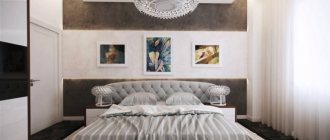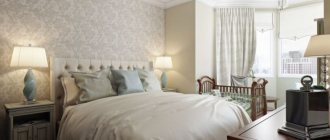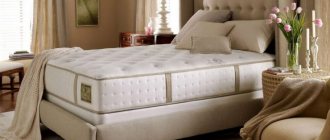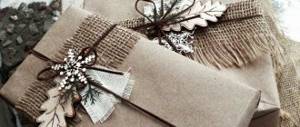What is a niche in the wall
A wall niche is a recess in the wall that plays a decorative or functional role and allows you to create original architectural compositions. Today, such niches are often created at the design stage, as they are extremely popular. However, almost anyone who wants to decorate their apartment can make special recesses.
Vertical niche
Vertical recesses in the wall are used to visually increase the space in height. Such niches are placed next to a window, doorway, or where a minimum set of furniture is supposed to be placed.
By the way, furniture with a high back next to a vertical niche looks best. These recesses with elongated lines can be decorated with identical decorative elements on the sides. For example, chairs or floor flowerpots are used for this design.
Niches, elongated vertically, work as bookcases, dressing rooms, shelves for figurines and even key holders. Their application is extensive, and the design can be anything.
How to make a niche in the wall
You can make a niche in any wall, but to interfere with load-bearing walls you will need engineering permission and the consent of the relevant authority.
Making a niche in a load-bearing wall is much more difficult, but plasterboard partitions are easily amenable to any intervention and can be easily changed even independently, but this will require correct calculations and a special tool. Therefore, it is best to turn to the services of professionals who will quickly create a beautiful niche of the desired shape for you. After you make a niche, you need to take care of sound insulation by finishing the back wall with insulating material, or put cabinets in this place in the next room.
How to make a niche in the wall for a bed with your own hands?
A niche in the wall for placing a bed is called an alcove. If the volume of the room allows, such an opening in the wall can be used to advantage. Moreover, around the niche you can provide shelves for books and magazines, which will look quite aesthetically pleasing.
For those apartment owners who like to spend time reading before going to bed, this room needs additional lighting. Niches are always darker than the rest of the room. It's great for sleeping and relaxing. If you plan to build a niche in a country house, then you can make a small window. This will not only create additional comfort in this part of the room, but will also save on electricity.
In the photo there is a niche in the wall for a bed or alcove
An alcove is most often surrounded by walls on three sides. Housewives solve this problem simply. If you put a screen or hang curtains made of thick fabric, you will get a completely isolated, cozy room in which you can relax even on the sunniest day.
Making a niche in the wall for a bed is especially beneficial in small rooms, where free space is at a premium. In this case, designers recommend purchasing a transforming bed. It is quite compact and equipped with a lifting mechanism. Despite the heaviness, the bed on powerful springs easily rises and even a child can cope with the task. The bed can be completely hidden in a niche, freeing up room space for its owners.
Niche in the wall for a bed with a lifting mechanism
The alcove is made of plasterboard. To do this, you need to take the dimensions of the bed and perform calculations so that it fits freely in the space allotted to it. We recommend following these steps:
- Make the markings on paper, then transfer the markings to the wall.
- Cut the material in the required quantity according to the planned dimensions.
- Attach the guide profile to the floor, wall, ceiling using dowels.
- Install vertical and horizontal posts from the profile.
- Provide lighting. It is important to do this before installing drywall to hide all wires and other communications.
- Drywall sheets are installed using self-tapping screws and a screwdriver. All joints between the sheets are glued with sickle mesh and puttied.
- The final stage is painting with water-based paint.
Now you can start implementing your design ideas. Bringing them to life is not so difficult. The photos presented on the site will help with this and your alcove will look decent.
Beautiful design of a niche in the wall: what materials are suitable?
Almost any materials are used to decorate a niche in the wall. Much depends on the purpose for which it was created and what taste the apartment owners have. The most popular materials for room decoration are:
- decorative stone is a practical solution, however, when decorating a sleeping place, craftsmen recommend choosing a stone without sharp edges;
- laminate is a material that is inexpensive, quick to install, easy to maintain, and hides defects and design errors;
- fabric upholstery is an original solution for decorating a niche for a bed or sofa;
- Photo wallpaper is a simple and inexpensive way to get rid of all the problems with room decor.
Beautiful and original design of a niche in the wall
Those who love aesthetics can install a large mirror on the back wall. In this case, the room will look beautiful and visually larger. Caring for a mirror niche is easy, but you need to be careful not to accidentally break the glass while sleeping. If the niche is intended for a child, mirror decoration of the room is not recommended.
Wall niche design
Modern niches are no longer just a recess in the wall intended for vases and figurines, but a harmonious space with an individual color scheme and lighting system.
Designers distinguish two ways to design a niche - using a contrasting or similar shade. It is not recommended to paint the recesses in dark colors, as the niche will look like a “black hole”.
It is better to prefer calm pastel shades or bright colors. It is also worth paying attention to the shape of the niche. Horizontal is suitable for rooms with low and long furniture, such as a bed or nightstand. Also, a horizontal niche can visually lengthen a short wall. A vertical niche will look good next to a window, door, bulky chest of drawers or closet.
Bed in a niche: photo
Among all the variety of design solutions, it is difficult to choose something specific, but we still recommend looking at a small photo selection with original ways to design niches in bedrooms.
Niche in the wall: what can be placed in it
Typically, niches contain decorative elements, vases, figurines, bookshelves, or hide massive parts of cabinets and other furniture, household appliances and electronics. In some apartments there are natural niches, for example, recesses in the kitchen and bathroom, necessary for the ventilation system, recesses near the fireplace and radiator, protruding parts of the walls of frame houses with pillars also form natural niches.
In the niches you can place small shelves for decorative items , paintings, photographs, vases, and even place a library there. They are also perfect for placing cosmetics and other small items; such a niche is ideal for the bathroom.
Niche design
The modern design of a niche where you plan to install a sofa will differ from the design where you need to place many small elements.
Niches near the furniture are decorated with photo wallpapers, paintings, bright color accents and lighting. They are shaded with decorative plaster, wallpaper and drawings. They are decorated with columns, door jambs and stucco moldings.
The recesses for placing decor are made of the same color as the entire color scheme of the wall. Sometimes consonant shades of colors are used. But all color transitions here should be smooth.
The space in the recesses is not darkened too much. Dark spots in the wall create the effect of a “black hole” and look inharmonious.
Depending on the style, the recess can be decorated with stone, brick and even newspaper clippings. Particularly creative niches are decorated with decoupage or mosaics.
Using lighting in the wall, you can create a stained glass window, as well as a false window, which is fashionable today. It all depends on the design of the room and the appropriateness of this technique in it.
In small rooms, alcoves are not made too deep, but large spaces with significant recesses look harmonious.
In the living room
In the living room, this decorative element is combined with a shelf for a TV. Used as a space-zoning element. Empty walls are filled in this way.
In the living room, the protruding space by the fireplace is complemented by wall-length niches. There are books, pillows and much more.
The idea of a recess opposite the window allows for maximum use of natural light for the recreation area created there.
A simple couch looks good in exedra. You can lie on it and enjoy music, like the Romans or Greeks.
In a one-room apartment there may be only one niche, but its size is determined by the free space.
The designer may recommend making a niche in the living room in the form of a place for firewood or a cabinet for many books and magazines. But you can create a recess for anything, such as wine bottles.
In the bedroom
A common option for a niche in the bedroom is a recess for placing a bed. Modern technologies make it possible not only to install a sleeping place in a niche, but also contribute to the creation of such structures when the bed is completely retracted into the recess during daylight hours.
The shapes of niches in bedrooms can be any. Most often, they look like oriental domes, arches, rectangular shelves, standard recesses. Several options for this decor in the bedroom look great.
In the children's room
In the nursery, the recesses are designed in the form of trees, ships, apples and houses.
They are used to create play spaces, bookshelves, sleeping areas and dressing areas.
The bright design of a niche in a nursery looks more appropriate than in another room.
Children really like these grooves. They make the room look cute and unusual. A niche in a nursery is an excellent solution for storing children’s toys and sports equipment.
In bathroom
A bathroom decorated with recesses becomes comfortable, romantic and functional. There will always be objects that will take their rightful place in the recess.
A washing machine, a laundry basket and bathrobes can all be hidden in a niche from prying eyes.
Even a shower stall or water tank in a niche looks more harmonious.
In the kitchen
This decor has many functions in the kitchen. And these functions depend on the style of the kitchen space:
- Rustic style. It implies the presence of shelves on which all necessary household items are installed;
- Country. Here the recess carries a decorative load;
- Classic style. In this direction you can see a hood in the niche;
- Retro. The retro recess is used to highlight still lifes and wall photographs;
- Modern style. Does not imply restrictions on the use of the niche. The most creative options, explosive colors and crazy decorative elements in a modern style are used everywhere.
All these options can be designed as contrasting spots on the kitchen wall, or they can be designed as a seamless continuation of a single interior idea.
To decorate an arch in a kitchen, you can use stones, mosaics, tiles, wall panels, wood and glass. The main thing is that these elements are easy to maintain and also fit into the overall concept.
In the hall
A corridor with a decoration such as a niche always outperforms a room with solid walls. Here soft lighting, baskets for keys and small items, hooks for hats and coats are used.
The decor of a hallway with a recess depends on the height of the ceiling. Walls that are too high can be visually grounded with niches located slightly below eye level. A corridor with a low ceiling can be visually extended by recesses located under the ceiling or above the middle of the wall.
The use of lighting in the corridor is most appropriate as an addition to the main lighting. The space at the entrance has no windows, so there is never too much light there. It is also possible to use a mirror to enhance the lighting effect.
Niche for large items
In addition to decorative ones, there are also functional ones, which are made specifically to accommodate various large items of equipment or furniture. They can accommodate a TV, stereo system, washing machine and furniture.
A chest of drawers, a sofa, a wardrobe, or a shelving unit placed in a niche allows you to save a lot of free space in the room and brings order to the interior. Particularly popular are cabinets built into the wall, which save as much space as possible. Household appliances placed in a niche, for example, a washing machine or refrigerator, will be practically invisible.
Small recesses can serve as a bookcase or shelves for dishes. Decorative niches are usually located in the most noticeable places where the eye lingers. The great advantage of such recesses is that you can often modify them by repainting, gluing, sheathing and adding various elements.
How can it be used in the interior?
The practical use of a recess depends on the room where it will be used, as well as on the designer's flight of thought. Let's look at the most common options for using niches:
- Bookshelf. This option saves space, looks stylish and relevant, and helps to functionally store books and magazines;
- Closet. Here the purpose of the cabinet can be anything. Open cabinets contain photographs, collections of interior items, vases and candles. They also install closed modules for storing shoes or bedding;
- Space for household appliances. An extremely useful thing in the kitchen. A dishwasher is built into the large arch, and coffee makers and microwaves are installed in small niches;
- Bed area. A sofa or bed placed in a recess looks organic. This method saves space in the room, makes the overall interior composition more complex and harmonious;
- Place for bath accessories. The bathroom is a corner of comfort where a decorative cave looks perfect. Stacks of elegant towels, candles, oils and any other items are placed in it;
- Greenhouse. Shade-loving plants in a niche will feel just great. And if we are talking about living creatures, then a house for a cat can also be arranged in a recess.
In addition to their functional purpose, recesses in the wall are divided into shapes and types. The table below contains information about the relationship between the type of niche and its location.
| Type of recess | Use case |
| Horizontal | Living room, bedroom, hallway, bathroom. |
| Vertical | Office, living room, hallway, children's room, kitchen. |
| Non-standard | Children's room, living room, loggia, bathroom, common hall in the house. |
| Composition of recesses | In any room. |
These options are not a design axiom; they are given to make it easier to choose a place for a certain type of niche.
A non-standard niche is understood as recesses in the form of fruits, waves, circles. In general, this concept includes everything that does not fit into the framework of vertical and horizontal lines.
A niche is not only a beautiful decorative element, but also a completely functional architectural detail. When choosing the type of niche, you should consider its harmonious combination with the furniture in the room. If the furniture decor is dotted with monograms, curls and carved elements, the recess lines should be rounded or broken. The standard rectangular option is combined with furniture in a minimalist style.
Closet
Which recess makes a cabinet? In addition to being unusual, it also saves space. Away with boring cabinet options, a niche will cope with this purpose much better. A book niche, for example, can be decorated with columns. Then the books on the shelves will become more visible and meaningful. The wardrobe recess is complemented with clothes hangers and shoe cabinets. A cabinet with a niche for crafts and decorations can be equipped with transparent shelves so that the beauty of the contents is as visible as possible to others.
In the bedroom, not only a bed is placed in a niche, but also an antique chest for bed linen. In the living room, grandma's sideboard can be successfully replaced with an elegant recess in the wall.
For household appliances
In the kitchen, wall recesses are needed most of all. All household appliances fit harmoniously into them. It’s no wonder that among household appliances there are so many built-in analogues.
In small recesses you can place original jars with spices; ladles, frying pans and various oven mitts with interesting designs also look good there.
A hood or kitchen fireplace will also take its rightful place under the arch. Want to create a small wine cellar in your kitchen? Make it in a niche.
Workplace
The good idea of a workspace in a living room is that it creates an unusual image without overloading the space with unnecessary details. The niche can serve as both a desk and a shelf for working tools.
Its use in this embodiment is appropriate where compact location is an urgent need.
When the ceiling in the room is sloping, and if the room is an attic, the natural recess can be used to organize a workspace.
Lighting for niches in the wall
Most modern decorative niches today are equipped with lighting, which can be located on top or on the side.
In the evening they can be used as a source of dim lighting. The number of niches located in one room may vary. If you make several recesses in the wall, they must be “rhythmic”, that is, they must be located at a specific distance with a certain frequency, and their design must match.
Horizontal niche
A horizontal niche is most often used in a classic style. Its application extends to a wide variety of areas, and its functionality is very great.
A wide recess can visually lengthen a room. The use of this decorative element can be found in living rooms and halls. A niche located above eye level solves the problem of a low ceiling, as if raising it a few centimeters.
These recesses are combined with low furniture. It is this version of the furniture ensemble that best emphasizes the advantages of horizontal niches.
Niches elongated in width are used in small rooms. They are made homogeneous or divided into several sectors, creating a gallery effect. With this arrangement, the horizontal recesses can be located above each other, or stretched along the wall.
Any horizontal recess can add a little more coziness and comfort to the overall interior of the room. The recesses in the wall look a little mysterious and non-trivial, giving the space around a slight air of mystery.
Niche in the wall - photo
Niche in the wall: how to design it correctly?
One of the interesting and attractive decorative elements in interior design is a niche in the wall. But in order for it to harmoniously fit into the style of the room, it should be correctly positioned and decorated accordingly. For the most part, the relevance of a niche in a room depends on its location, decorative design and functionality. Let's consider in what cases a niche in the wall would be appropriate, how to design it, and whether it should perform any functions.
A little history
Such a charming decorative element as a niche in the wall came into interior design from rustic styles, where people, even when building houses, made recesses in the walls for shelves in advance. The niches here were intended for storing various household items. In southern country styles until modern times, niches in the wall were also quite common and performed the same functions. Now in country styles, such recesses are painted the same color as the main wall.
Now niches are most often used as an original decorative element in interior design, and they do not perform any functions. But there are exceptions, which we will consider further.
Niche in the wall: functions in the interior
A niche in the wall always serves as a shelf that does not particularly occupy the space of the room. In bedrooms, such recesses in the walls are often located at the head of the bed. In this case, it serves both as a decoration for the room and as a convenient shelf.
It is best to install decorative lighting in such niches, which will give it more originality. But the presence of bedside lamps is still mandatory, since reading when lighting a niche is almost impossible.
A niche in the wall can serve as furniture for a TV or music equipment. But in this case its size should be quite large. Such interior design is relevant for spacious rooms, as it reduces the area of the room by at least 40 cm. In the photo below there is a huge room where there is an entire wall of niches, which serves as furniture for TV and shelves for decorative items. Judging by the size of the room, the owners did not lose too much of its space when creating such an interior.
In the kitchen, a niche in the wall always serves as an additional shelf for kitchen utensils, slightly decorating the interior.
It is best to use one or more niches as an element of room decor. Even if they are not only an addition to the interior, but also serve as shelves for storing some things, niches in reasonable quantities can decorate a room. If you place many niches in the wall and fill them with books or other non-decorative items, an atmosphere of bad taste will be created, and the wall will look like a shelving unit.
In addition, you can’t decorate such a wall with anything: it’s impossible to hang a picture or a shelf on it, or put a chest of drawers or a cabinet on it. You should not once again attribute any additional functions to the niches in the wall. For example, to store books, it is better to use a regular shelving unit rather than many niches scattered all over the wall. In other words, it is better for a small recess in the wall to serve solely as interior decoration. Using this decorative element as furniture is not always relevant, so let’s figure out how to properly plan a niche in the wall.
Planning a niche in the wall
When planning the placement of niches in the wall, you should draw a picture of the future room in advance. One of the common mistakes is placing a niche where the furniture will stand. When the furniture covers part of the recess in the wall, firstly, free access to it is difficult, secondly, it looks ugly, and in general, in such cases the niche will be simply superfluous and can even spoil the interior of the room.
Since a niche in the wall is purely a decorative element, it is not at all necessary to make many such recesses. It’s enough to decorate one or two beautifully and originally. This is especially true for bedrooms and living rooms. If there is an empty wall in the bedroom or living room that is difficult to decorate with anything, the best option would be to decorate it with a niche. It can serve as the only decorative element, without which the room would look empty and boring.
The size of the niche in the wall should also be wisely planned. If the interior of the room is light, with a minimum amount of furniture and other items, a large niche will not be able to fit into it organically.
The location of niches in the wall along the stairs is an almost irreplaceable decorative element in such areas.
In the hallway, an excellent addition to the interior design will be several niches in the wall of different sizes.
Next, it’s worth figuring out how many niches in the wall are best placed, and how to arrange them correctly.
How to place a niche in the wall?
There are three options for the correct location of several niches in the wall:
1. Asymmetrical grouping of small niches on one section of the wall;
2. Asymmetrical arrangement of niches on sections of the wall not used for other purposes;
3. Symmetrical placement of identical niches relative to the doorway, window, bed or other furniture.
It is possible to create a dynamic interior of a room by asymmetrically arranging niches in the wall. Illuminated recesses of different sizes, arranged in this way, look charming. They are preferably placed on those sections of the wall that are not used for other purposes. In addition, in such areas of the wall you can place a niche in a single copy.
To give the room geometric precision, square niches of the same size are placed symmetrically in the wall.
The combination of colors emphasizes the original taste of the owners. Therefore, it is better when the color of the interior space of the niches is combined with the color of other areas of the room or decorative elements. For example, in the photo above, the colors of the niche lighting are combined with the delicate peach color of the chandelier.
A room with one large niche in the wall, asymmetrically divided into several small ones, looks amazing. You can place a collection of souvenirs in it, if it is large, so that everything is in one place.
Decorating a niche in the wall with lighting
A niche with lighting is an easy way to complement the interior of a room with a play of light and shadow, and it’s also inexpensive. Therefore, such decorative elements in a modern interior are almost always illuminated. But the lighting of the niches should harmoniously fit into the interior design, as well as the combination of the color scheme of the room. The main thing in decorating a niche is to use lighting where it is needed.
In rooms where there is already a lot of light, for example, the ceilings and some corners of the walls are illuminated, lighting a niche in the wall can become unnecessary and create a cold, office atmosphere in the room. In this case, it is more important to reduce the amount of lighting on the ceiling than to leave the niche unlit. In addition, the color tone of the ceiling and niche lighting should be harmoniously combined.
It is better to illuminate the niche in a diffuse way, since in intense light the decorative accessories in it will not look very nice. Intense spot illumination of the niche provides directional light, creating high contrast inside it. At the same time, objects inside the niche lose some of their color: the areas to which the light is directed appear white, and the areas that the beam does not hit look too dark.
This lighting is suitable for niches containing objects made of gold or crystal. In directional light they will flicker and sparkle interestingly.
It is better to illuminate any shiny objects in a niche with intense lighting; other accessories look great under soft diffused light. As for the items that can be placed in a niche, it can be anything, the main thing is that the accessory is matched to the interior of the room.
Classic interior style: designing a niche in the wall
The classic style of the interior assumes the presence of a niche, the upper part of which is rounded like an arch. The decorative element is almost always decorated with a white frame. For a classic interior style, it is preferable to place a vase of flowers or a black figurine in a niche. As for the color scheme, the internal surfaces of the niches are painted a different color in relation to the walls.
If retro style motifs are found in a classic interior, a collage of family photographs, flowers or paintings is placed in the niches. Illumination of niches in retro and classic styles is often absent, and they are always located symmetrically.
Modern interior style: designing a niche in the wall
Niches in the walls in a modern interior style are designed as your imagination allows. They can be painted in any color or several shades at once, illuminated, glazed, and arranged asymmetrically. In addition, they are simply cut out in drywall and are almost never framed.
Correct design of niches in the wall: colors and objects
In order for a niche to fit harmoniously into the interior of the room, it is necessary not only to position it correctly and select matching shades, but also to place suitable decorative items in it. For example, in the photo below, the room is in brown tones, the inner surfaces of the niche are painted the same color as the walls, but due to the backlight they look a little lighter, which is very eye-catching. Items in niches also fit harmoniously into the interior.
In the next photo, the inner wall of the niche is lined with the same decorative stone as the wall opposite. In addition, the combination with the tone of the chandelier gives the interior a special originality.
It is worth noting that accessories for a niche must match its size. That is, if the niche is large, and the objects in it are small, we can assume that they were placed there by accident, without thinking at all about the interior design. Leaving niches empty is also undesirable. In the photo below, there are three empty niches in the wall on the right, which looks ugly. If there is no object suitable for the interior, it is better to leave the wall flat and hang a picture or mirror on it. These decorative items will decorate the interior much better than an empty niche in the wall.
As for the color of the interior surfaces of the niche, it is selected to match the tone of the main walls or other decorative items, as well as furniture. The main thing is that the niche in the wall does not stand out too much due to its color, but also does not remain completely invisible, then it will simply be superfluous in the interior.
If you still decide to make a niche in the wall, then watch the video on how to do it:
How to use a niche in the wall
There are many opportunities to use such a convenient detail of the room. Here is just a small list, although the flight of imagination is unlimited here:
– Specially selected built-in furniture.
– Stylishly designed home library.
Arranging a library in a wall niche
– TV, audio equipment and other home appliances.
– Closed linen closet, convenient and suitable for the interior.
Closed cabinet in a niche
– Mini-exhibition of photographs, certificates or valuable objects of art.
Placing the collection in a niche
This is a small list of possibilities, limited only by your imagination. It is worth noting that even an unused niche expands the space, especially if you have a small apartment. Extra space in such a room will never hurt, but quite the opposite - a niche can accommodate anything and will not require space for it. Moreover, it can be placed in absolutely any room, and even on the balcony.
